Timing Low Volatility with Factor Valuations
How Important Are Valuations for Expected Returns?
February 2020. Reading Time: 10 Minutes. Author: Nicolas Rabener.
SUMMARY
- Factors can be valued like stocks or markets
- The Low Volatility factor in the US had the best subsequent returns when cheapest and worst when most expensive
- However, the perspective is less clear when analyzing European and Japanese stock markets
INTRODUCTION
Funds flows are frequently analyzed by investors to gauge the demand for investment strategies, but it represents a challenging exercise. Key issues are data availability as few market participants disclose their holdings and reporting frequency as limited data is published in real-time.
The resulting headlines in media, therefore, are often confusing, although they naturally also reflect that fund flows can change quickly as investor sentiment shifts. For example, glancing at a few headlines regarding the Low Volatility factor from the last few months would likely leave investors questioning whether this strategy is popular or not.
- Investors quickly tired of Low Volatility ETFs (Investopedia, 25th June 2019)
- Money is pouring into Low-Volatility Funds (WSJ, 4th August 2019)
- Min / Low Volatility in demand on macro concerns (ETF Stream, 25th August 2019)
- November rally weighs on Low-Volatility funds (WSJ, 11th November 2019)
The interest in fund flow data is either based on evaluating the potential for returns or risks of an asset class or strategy. The more demand from investors, the higher the returns should be as new money will drive prices higher. However, if a strategy becomes too popular and there are few buyers left, then it might be considered crowded and become prone to drawdowns when the popularity fades.
A simpler and more established method of evaluating the risk-return profile of a strategy is valuation, where high-quality and real-time data is available. Although valuation is common when analyzing stocks, it is less frequently applied when evaluating the attractiveness of factors.
In this short research note, we will evaluate the relationship between the fundamental valuation and subsequent returns of the Low Volatility factor (read Low Volatility: High Factor Valuation).
METHODOLOGY
We focus on the Low Volatility factor in the US, European, and Japanese stock markets. The factor performance is calculated by constructing a long-short beta-neutral portfolio of the top and bottom 30% of stocks ranked by their 12-month volatility. Only stocks with a minimum market capitalization of $1 billion are included. Portfolios are rebalanced monthly and each transaction incurs costs of 10 basis points.
LOW VOLATILITY FACTOR ACROSS MARKETS
The Low Volatility factor became popular with investors after 2009 as low-risk stocks experienced a lower maximum drawdown than the stock market during the global financial crisis. The factor has also generated the best performance over the last 30 years compared to other common equity factors like Value or Momentum (read Low Vol Factor: From Obscurity to Stardom).
Contrasting the performance of the long-short factor across markets highlights similar trends that imply common drivers of performance. The returns were strongest in the US and the weakest in Japan, which has been the same case as for other factors. We observe that the strategy experienced a significant drawdown during the tech bubble in 1999 to 2000 when investors exhibited a strong preference for volatile technology stocks like Cisco Systems over unexciting, low-risk stocks such as Berkshire Hathaway.
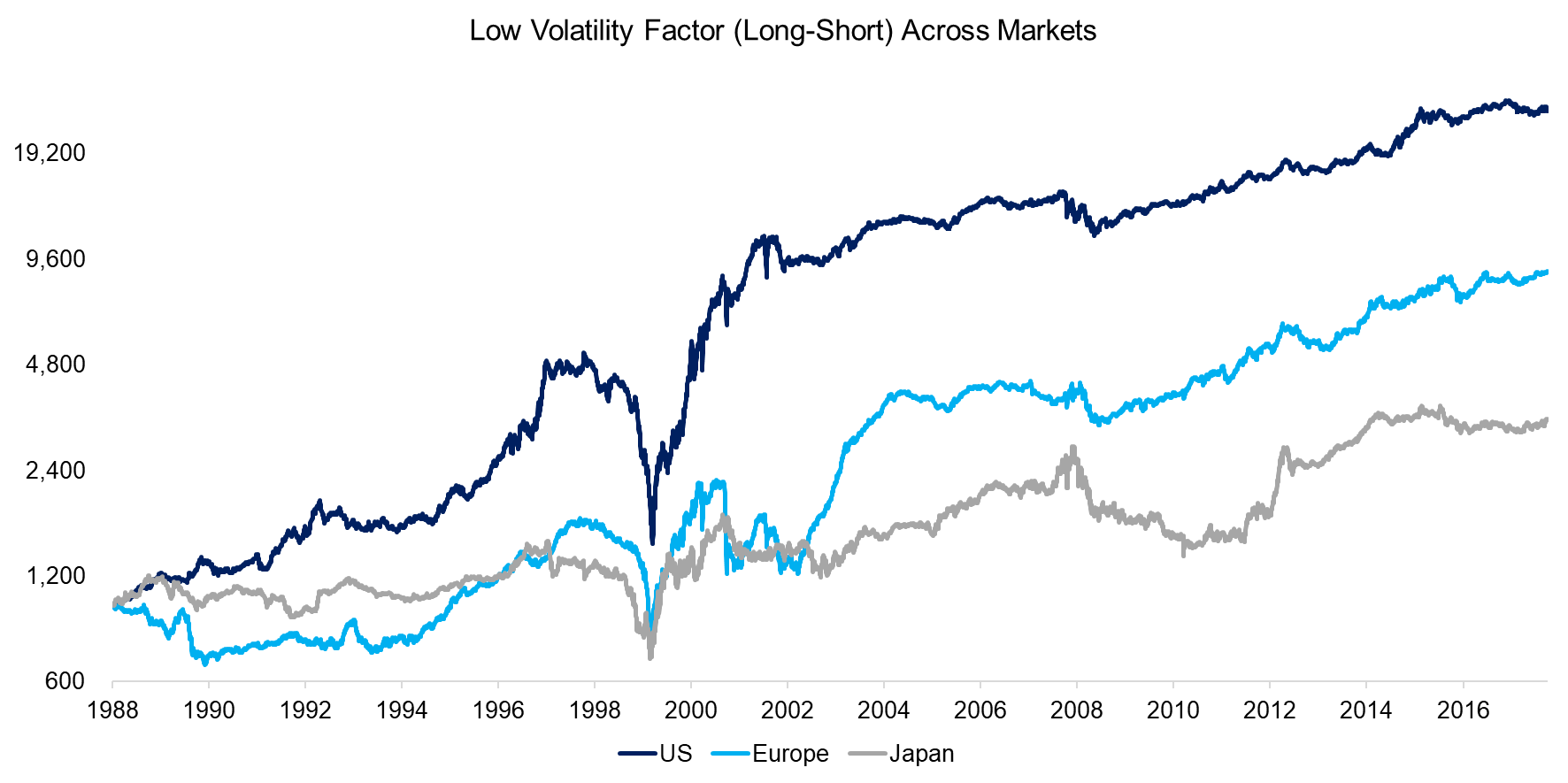
Source: FactorResearch
FUNDAMENTAL FACTOR VALUATION
Investors use fundamental valuation metrics for evaluating single securities as well as entire markets. We can use the same methodology for measuring how cheap or expensive a factor is trading relative to its own history. Specifically, we calculate the median price-to-book multiples of the long and short portfolio of the factor, where the difference represents the valuation spread. The higher the spread, the more expensive the factor from a fundamental perspective.
Applying this methodology to the Low Volatility factor in the US highlights the extreme trading conditions during the tech bubble when volatile stocks traded at abnormally high multiples compared to low-risk stocks. We also observe that in the period from 1988 to 2002 the valuation spread was consistently negative while it occasionally became positive thereafter.
The long portfolio tends to be dominated by stocks from the real estate, utilities, and telecom sectors, which feature structurally high leverage and have benefited from decreasing interest rates post the global financial crisis. However, the median price-to-book multiple of the long portfolio has remained relatively flat over time and the change in valuation spread is explained by volatile stocks becoming less expensive.
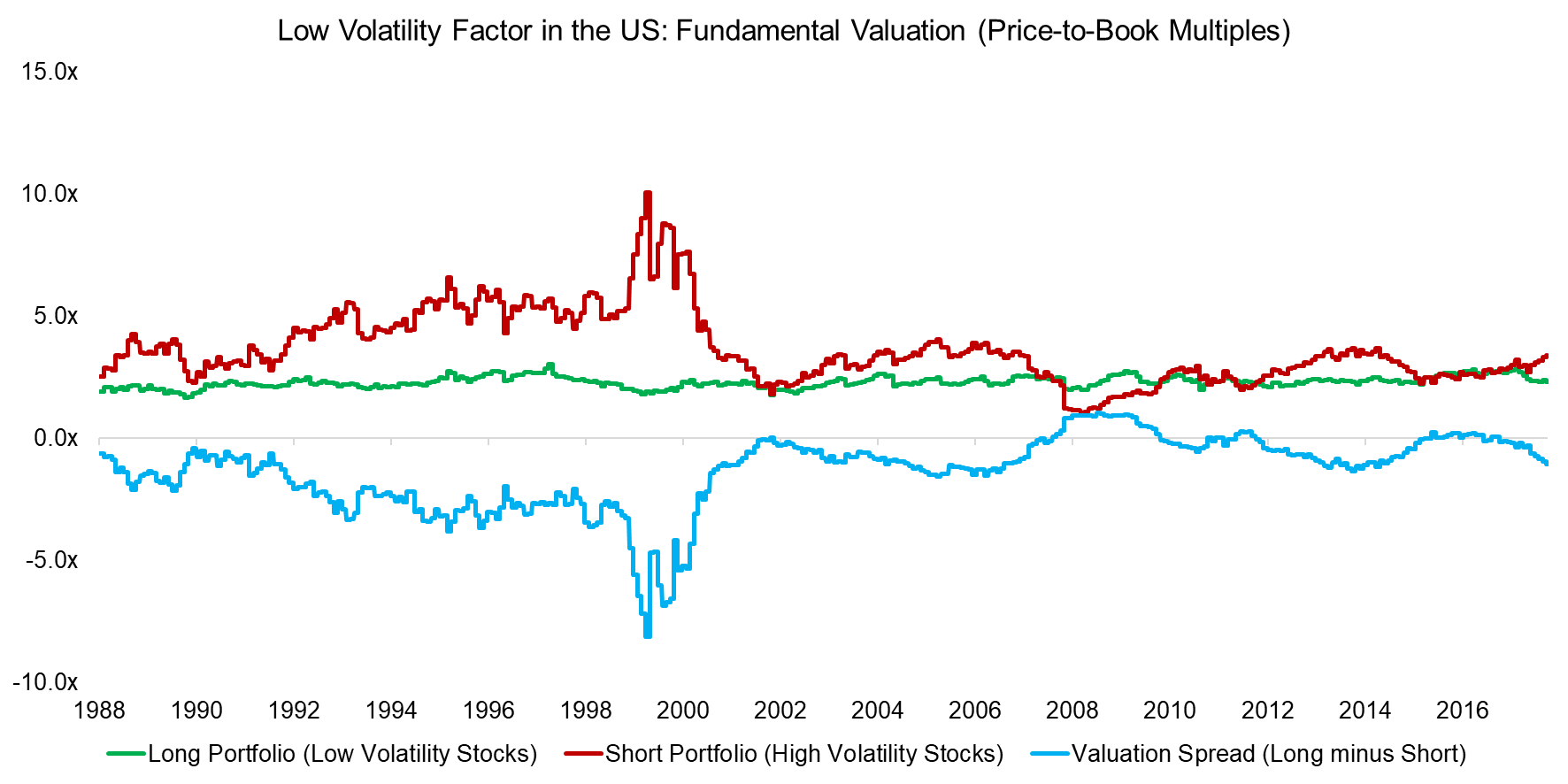
Source: FactorResearch
It is worth highlighting that the valuation spreads, similar to the factor performance, exhibited the same trends across regions in the period from 1988 to 2018. However, the absolute levels were substantially different with the average valuation spread being more negative in the US than in Europe and Japan. This implies more dispersion of valuations between low-risk and volatile stocks in the US than in other markets, which perhaps is explained by a larger universe of stocks.
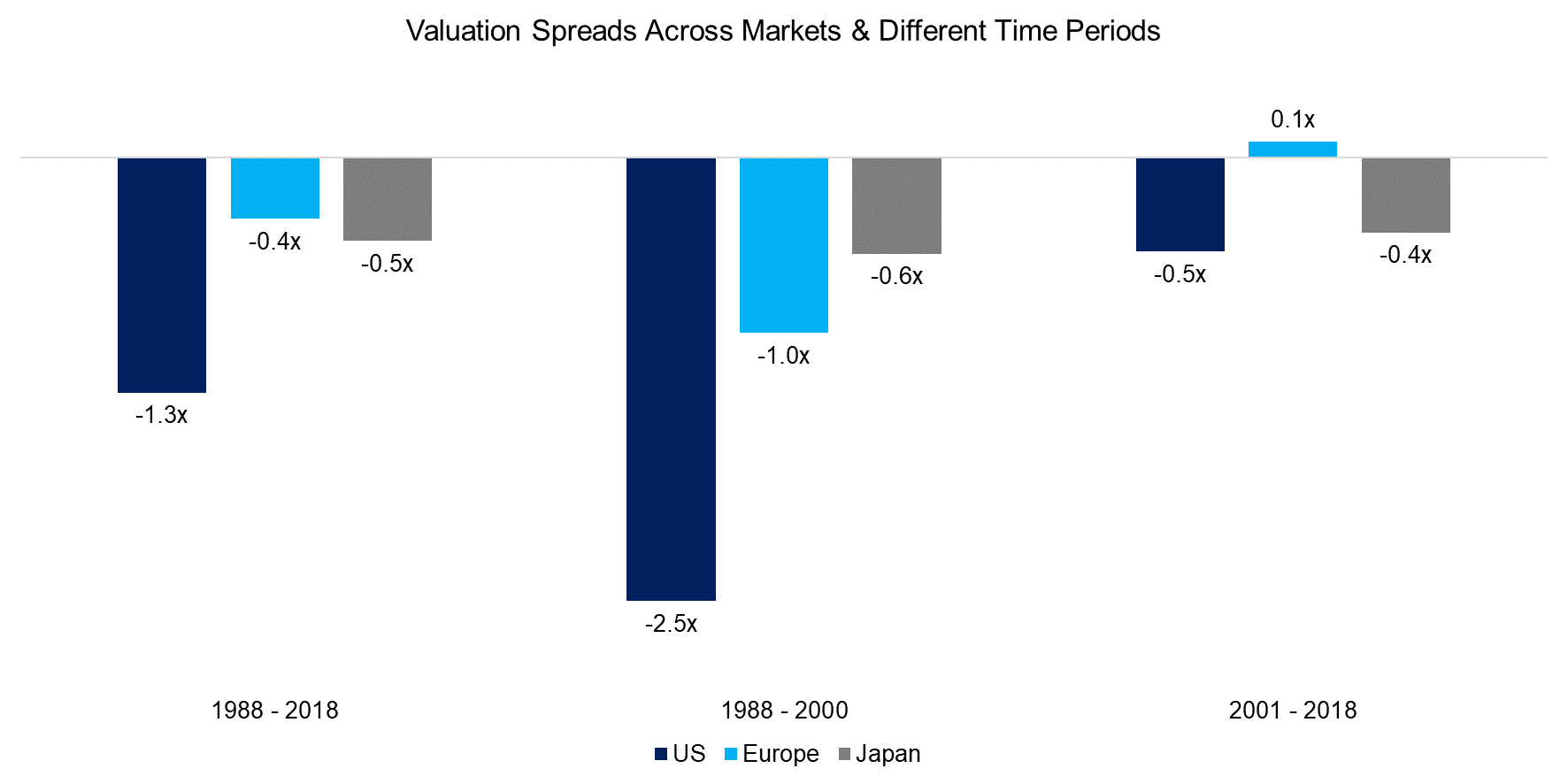
Source: FactorResearch
FACTOR VALUATION & FORWARD RETURNS
We separate the valuation spread of the Low Volatility factor in the US from 1988 to 2018 into quintiles, which results in five categories that are labeled from most expensive to cheapest. We then measured the forward CAGRs for the next 6 months, next one year, and next three years on a daily basis and average the returns for each of the quintiles.
The analysis highlights that the subsequent returns were higher in the US when the factor was trading cheaply, although it is not a strictly linear relationship. Investors can challenge the analysis as it represents in-sample data and it should be verified out-of-sample or across other regions.
However, based on this result, investors might be intrigued to time an allocation to the Low Volatility factor based on where it is currently trading.
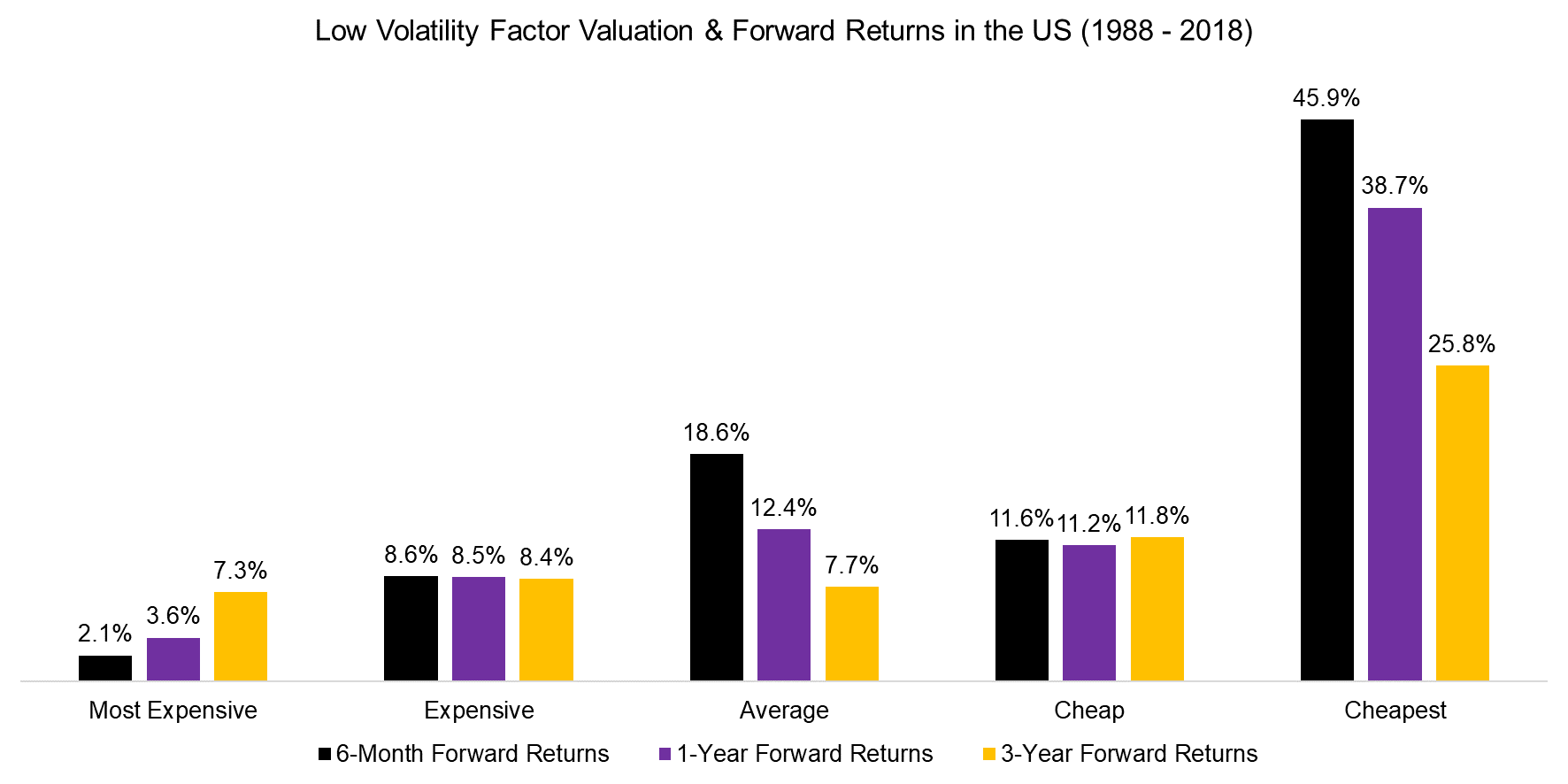
Source: FactorResearch
We extend the analysis to Europe and Japan, which creates a more differentiated perspective on allocating to the Low Volatility factor based on its fundamental valuation.
In Japan there was little difference in 1-year forward returns, except when the factor was trading at its most expensive or cheapest valuations. However, in Europe, the subsequent return was lowest when the factor was trading most cheaply, which is not intuitive. This is explained by the periods from 1988 to 1990 and 1998 to 2002, where the valuation spread was at its most negative level, but the performance was also poor.
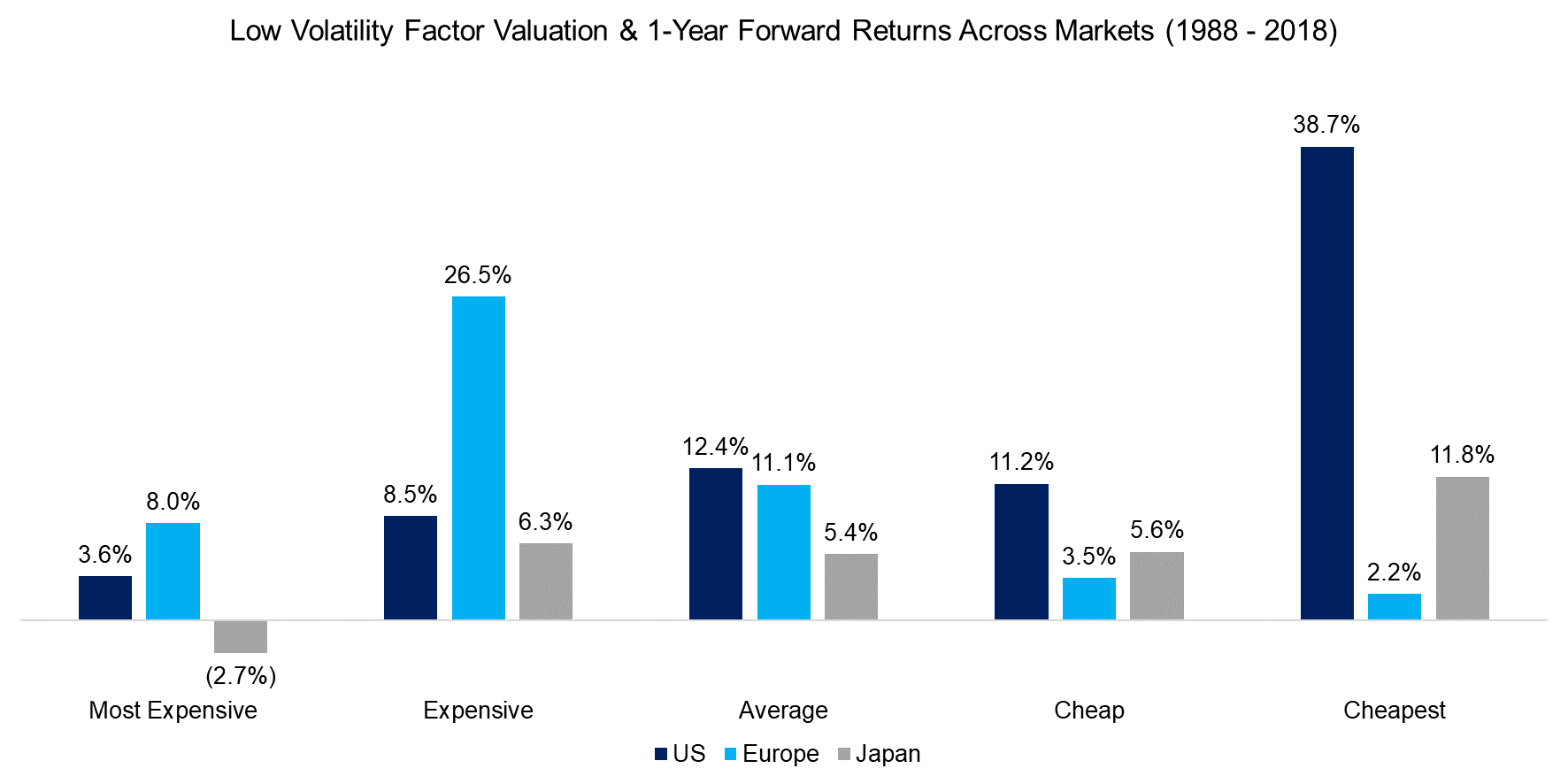
Source: FactorResearch
FURTHER THOUGHTS
Valuations are mostly used for comparing stocks relatively to each other, although the current valuation of the entire stock market is frequently contrasted to its own history. However, the risk of the latter approach is naturally that there have been structural changes such as the evolution of economies, e.g. the US from an emerging market into a technology-focused developed one over the last century, and changes in accounting standards.
Timing an allocation to a factor like Low Volatility solely based on the fundamental valuation is risky, however, it likely is accretive as a component in a multi-metric framework. However, market or factor timing is difficult and investors should best shift their perspective from improving returns to reducing risk, which is more realistic to achieve.
RELATED RESEARCH
ABOUT THE AUTHOR
Nicolas Rabener is the CEO & Founder of Finominal, which empowers professional investors with data, technology, and research insights to improve their investment outcomes. Previously he created Jackdaw Capital, an award-winning quantitative hedge fund. Before that Nicolas worked at GIC and Citigroup in London and New York. Nicolas holds a Master of Finance from HHL Leipzig Graduate School of Management, is a CAIA charter holder, and enjoys endurance sports (Ironman & 100km Ultramarathon).
Connect with me on LinkedIn or X.

